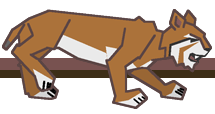in food chains; that organisms and resources in
an environment are closely linked. Overview & Teachers’ Guide.
The panel on the right contains an interactive diagram of the taiga food web. Click ‘ENLARGE’ to see a larger version of the diagram. Click ‘Start’ in the bottom right-hand corner and read about the food web. Click ‘Continue’ when you are ready to move onto the next page. Click ‘NORMAL VIEW’ to return to this page. When you have read the information and investigated the energy links between the organisms, click through the tabs at the top of this panel: ‘Inform’, ‘Question’, ‘Challenge’ and ‘Hypothesise’. The ‘Links’ section has some useful websites to help you with your research. You can then move on to investigate the Biomass Pyramid, the Energy Pyramid and Energy Optimisation by clicking the links at the top of the screen. Additional teacher's note Use the taiga food web as a stimulus to start students thinking about food webs in general - from the diagram they will realise how complex these can be. A key question to stimulate discussion might be: 'What information can a model like this actually give us?' This question can be used to explore what students already know about food chains and food webs, and to introduce and use key vocabulary. In the diagram itself, click on any element of either the lynx or snowshoe hare food webs. While doing so, explain that it is the feeding relationship between these two animals that will be explored during the Main session. |
